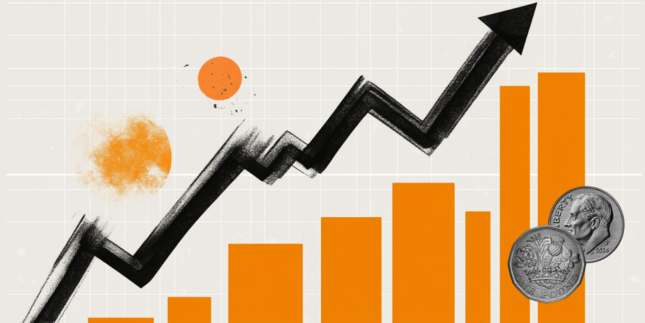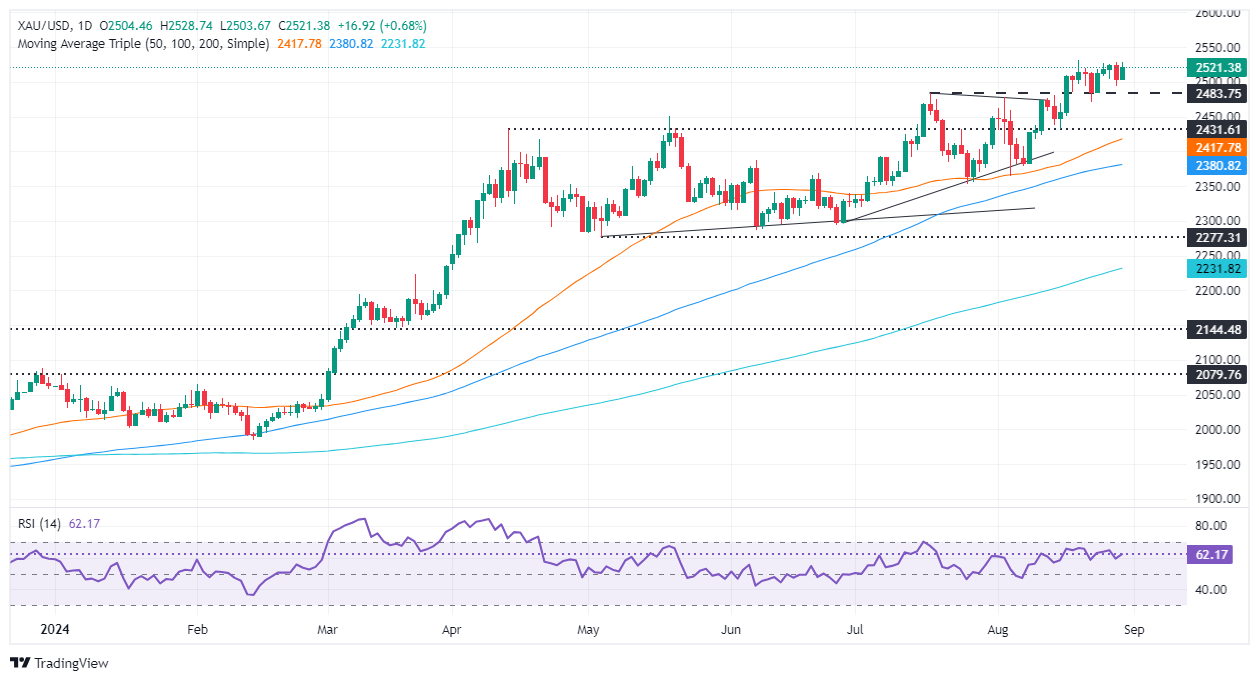- Gold prices climb despite upbeat US Q2 GDP revision and drop in unemployment claims.
- Despite rising US Treasury yields (10-year at 3.86%) and DXY up 0.33% to 101.38, Gold's upward trend continues.
- Focus shifts to upcoming core PCE data, expected to slightly increase, potentially impacting Fed decisions.
- CME FedWatch Tool shows 65.5% likelihood of a 25 bps rate cut in September, bolstering Gold prices.
Gold prices rose late in the North American session even though the US economy remains resilient after Gross Domestic Product (GDP) figures propelled the Greenback higher. Despite this, Gold prices continue to grind higher amid expectations of the Fed's first rate cut. The XAU/USD posted gains of 0.78% and exchanged hands at $2,523.
Market sentiment is positive, as traders remain laser-focused on data that could confirm the size of the Federal Reserve’s (Fed) first rate cut. In the meantime, the US Bureau of Economic Analysis revealed the country grew in Q2 2024 above the preliminary release, lifting the Personal Consumption Expenditures Price Index (PCE) Deflator with it.
At the same time, the US Department of Labor revealed that fewer than expected Americans applied for unemployment benefits, which is a relief for the Fed, which acknowledged in Powell’s speech that employment risks are tilted to the upside.
Despite that, the golden metal extended its gains above $2,520 even though the US 10-year Treasury note yield rose two basis points to 3.86%. Meanwhile, the US Dollar Index (DXY), which tracks the buck’s value against a basket of six currencies, climbed 0.33% to 101.38.
Given the backdrop, traders should expect that the non-yielding metal would aim lower, but investors see a 65.5% chance of a 25-basis-point (bps) rate cut at the September meeting, according to the CME FedWatch Tool, which underpins the precious metal.
On Friday, the Fed’s preferred inflation gauge, the core Personal Consumption Expenditures Price Index (PCE) is expected to tick a tenth higher, according to the consensus.
The December 2024 Chicago Board of Trade (CBOT) fed funds future rates contract hints that investors are eyeing 98 basis points of Fed easing this year, up from Monday’s 97.
Daily digest market movers: Gold price advances as traders brace for US Core PCE data
- If US economic data continues to be weak, the Gold price uptrend is likely to persist, fueling speculation about a larger rate cut by the Fed.
- The second estimate of US GDP for Q2 2024 showed a significant increase from 1.4% in Q1 to 3%, surpassing estimates of 2.8%. The Personal Consumption Price Expenditures (PCE) Deflator indicated that inflation dipped from 3.1% to 2.5% QoQ, slightly higher than the anticipated 2.3%.
- Initial Jobless Claims for the week ending August 24 decreased from 233K to 231K, slightly below the estimate of 232K.
- Next week, the US economic docket will feature the August Nonfarm Payrolls report, which could be crucial to assess the size of the Fed’s first rate cut at the September meeting.
Technical outlook: Gold price uptrend extends, traders eye $2,550
Gold price uptrend remains in place on Thursday. As price action pushes above $2,520, buyers remain hopeful that XAU/USD could climb past the all-time high (ATH) at 2,531. Momentum suggests buyers are in charge as the Relative Strength Index (RSI) portrays. Given that backdrop, Bullion’s path of least resistance is tilted to the upside.
If XAU/USD clears the ATH, the next resistance would be the $2,550 mark. A breach of the latter will expose $2,600.
Conversely, if XAU/USD slumps beneath $2,500, the first support would be the July 17 peak at $2,483. O; once cleared, the next support would be the $2,450 psychological mark, followed by the 50-day Simple Moving Average (SMA) at $2,414.
Inflation FAQs
Inflation measures the rise in the price of a representative basket of goods and services. Headline inflation is usually expressed as a percentage change on a month-on-month (MoM) and year-on-year (YoY) basis. Core inflation excludes more volatile elements such as food and fuel which can fluctuate because of geopolitical and seasonal factors. Core inflation is the figure economists focus on and is the level targeted by central banks, which are mandated to keep inflation at a manageable level, usually around 2%.
The Consumer Price Index (CPI) measures the change in prices of a basket of goods and services over a period of time. It is usually expressed as a percentage change on a month-on-month (MoM) and year-on-year (YoY) basis. Core CPI is the figure targeted by central banks as it excludes volatile food and fuel inputs. When Core CPI rises above 2% it usually results in higher interest rates and vice versa when it falls below 2%. Since higher interest rates are positive for a currency, higher inflation usually results in a stronger currency. The opposite is true when inflation falls.
Although it may seem counter-intuitive, high inflation in a country pushes up the value of its currency and vice versa for lower inflation. This is because the central bank will normally raise interest rates to combat the higher inflation, which attract more global capital inflows from investors looking for a lucrative place to park their money.
Formerly, Gold was the asset investors turned to in times of high inflation because it preserved its value, and whilst investors will often still buy Gold for its safe-haven properties in times of extreme market turmoil, this is not the case most of the time. This is because when inflation is high, central banks will put up interest rates to combat it. Higher interest rates are negative for Gold because they increase the opportunity-cost of holding Gold vis-a-vis an interest-bearing asset or placing the money in a cash deposit account. On the flipside, lower inflation tends to be positive for Gold as it brings interest rates down, making the bright metal a more viable investment alternative.
Information on these pages contains forward-looking statements that involve risks and uncertainties. Markets and instruments profiled on this page are for informational purposes only and should not in any way come across as a recommendation to buy or sell in these assets. You should do your own thorough research before making any investment decisions. FXStreet does not in any way guarantee that this information is free from mistakes, errors, or material misstatements. It also does not guarantee that this information is of a timely nature. Investing in Open Markets involves a great deal of risk, including the loss of all or a portion of your investment, as well as emotional distress. All risks, losses and costs associated with investing, including total loss of principal, are your responsibility. The views and opinions expressed in this article are those of the authors and do not necessarily reflect the official policy or position of FXStreet nor its advertisers. The author will not be held responsible for information that is found at the end of links posted on this page.
If not otherwise explicitly mentioned in the body of the article, at the time of writing, the author has no position in any stock mentioned in this article and no business relationship with any company mentioned. The author has not received compensation for writing this article, other than from FXStreet.
FXStreet and the author do not provide personalized recommendations. The author makes no representations as to the accuracy, completeness, or suitability of this information. FXStreet and the author will not be liable for any errors, omissions or any losses, injuries or damages arising from this information and its display or use. Errors and omissions excepted.
The author and FXStreet are not registered investment advisors and nothing in this article is intended to be investment advice.
Recommended content
Editors’ Picks

AUD/USD: Strong resistance lies at 0.6300
The marked sell-off in the US Dollar allowed AUD/USD to regain strong upside traction and reach multi-day highs in the area just below the key 0.6300 barrier at the beginning of the week.

EUR/USD: Bulls need to clear 1.0400 on a convincing fashion
In line with the rest of the risk-associated complex, EUR/USD managed to regain marked buying pressure and flirted with the area of three-week highs around 1.0430 on Monday.

Gold remains focused on all-time highs
Gold stays in positive territory above $2,700 on Monday as the improving risk mood makes it difficult for the US Dollar to find demand. Markets await US President Donald Trump's speech at the inauguration ceremony.

Solana Price Forecast: Are US traders dumping Bitcoin and XRP for SOL?
Solana (SOL) price stabilized near the $250 support level on Monday, having declined 10% from its all-time high over the last 24 hours.

GBP/USD stays defensive below 1.2200, awaits Trump 2.0
GBP/USD struggles to gain traction and trades slightly below 1.2200 in the second half of the day on Monday. Markets' nervousness ahead of US President-elect Donald Trump's inauguration drag the pair lower despite a broadly weaker US Dollar.

Trusted Broker Reviews for Smarter Trading
VERIFIED Discover in-depth reviews of reliable brokers. Compare features like spreads, leverage, and platforms. Find the perfect fit for your trading style, from CFDs to Forex pairs like EUR/USD and Gold.
